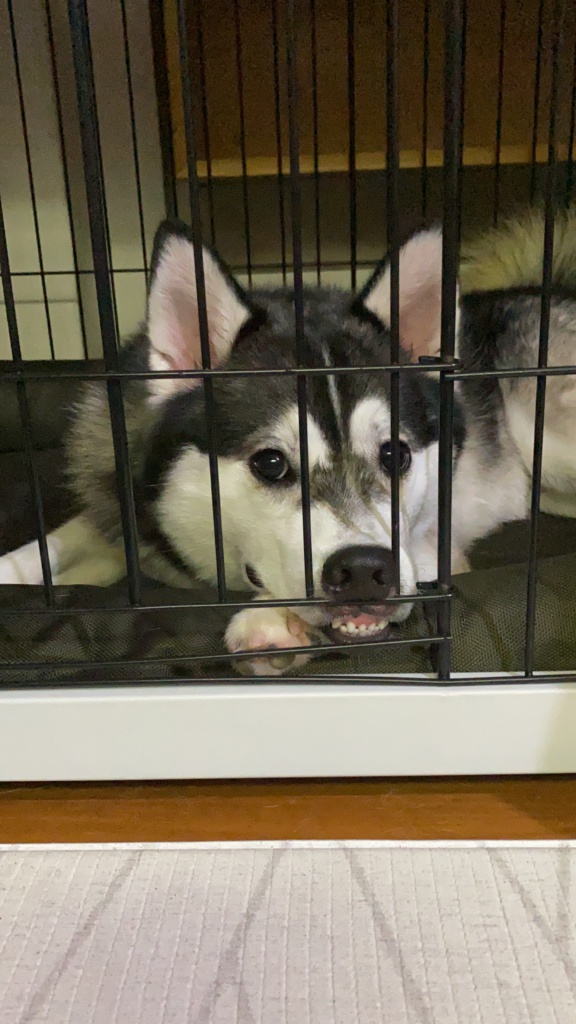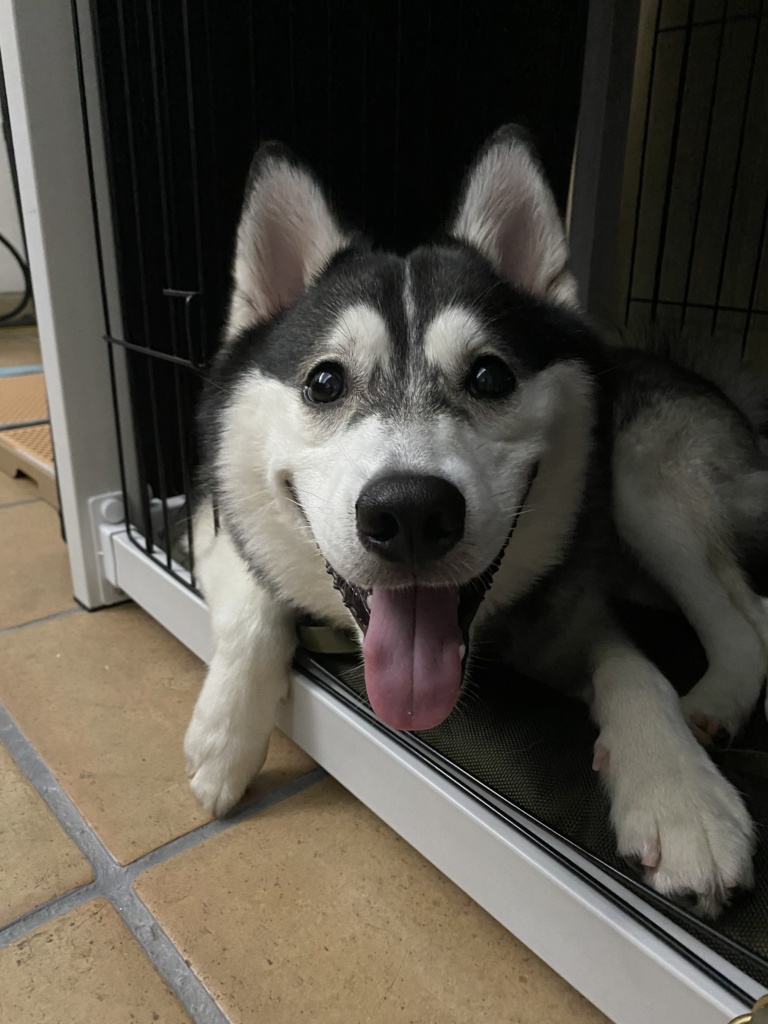With working from home restrictions slowly easing, pets raised during the pandemic may grow to develop separation anxiety once their owner is out of their line of sight.
In order to help pawrents whose dogs may suffer from separation anxiety, Team #TWA has reached out to QiuLi, AKA @taroandtoastie, to learn more about what it entails.
Read on to learn about QiuLi’s experience with crate training, and how Taro’s separation anxiety has since improved.
Experience with Crate Training
Hello! Tell us more about your relationship with Taro.
Hello! Taro is my first dog and I’m mainly the one feeding, training and playing with him that’s why he is very attached to me.

Being a first-time dog owner, I didn’t know much about dog training. At 3 months old, Taro was a little terror. He showcased slight aggression when handling, a tendency for resource guarding and kept chewing on things he’s not allowed to.
It definitely wasn’t what I thought having a dog would be like. But since working with him on setting structure and boundaries, our relationship definitely grew stronger and he is able to understand what is most expected of him.
What is separation anxiety and how does it affect your daily life with Taro?
I think Separation Anxiety in dogs is characterised by their inability to cope when left alone.
They would get stressed and start to whine, bark, howl, pace around. They just can’t seem to lie down and settle. If left to roam freely, they might even display destructive behaviours or have indoor accidents despite being potty trained.
As I work from home most of the time, Taro had always been by my side and follows me wherever I go into the house. He is only able to nap during the day if I am nearby or within his line of sight. Thus it became quite stressful, especially on days that I am heading out because he would whine the moment I accessed my closet.
If he’s allowed to free roam, he will obsessively follow me everywhere and start pacing around because he’s either excited that we’re heading out or panicking that I’m leaving him at home. I used to arrange for someone at home to accompany him but he refused to engage with family members either. He would just wait for me to come back and that’s when I realized I needed to do something to boost his independence and to have a healthier state of mind.
Bring us through a day of training with Taro.
Taro was crate trained since the day we brought him home. He is able to sleep overnight and nap during the day in the crate in the day but once he is awake he whines and barks to be let out. Other than that, he spends most of his time free-roaming throughout the house.
When I started working on his Separation Anxiety, I moved his crate out into the living room so he could learn to sleep overnight alone. The first night, he barked and howled throughout and would not settle down to sleep. After a week or so, he could sleep overnight without any whining. We also stopped engaging with him at home, refrained from giving him too much affection (though I still do sneak in some affection time haha) or playing excessively with him.

Hence, whenever he’s at home, he’s either in the crate or hanging out on the cot. We stopped letting him free roam the house as well. I would bring him down for potty and walks twice a day and I use his meals to do training for some mental stimulation. When we go outside, I would use his toys to engage with him. This taught him to focus better despite having distractions.
On days when my family members are not at home, I will also take the opportunity to leave him alone in the crate while I sit outside the house and observe him through the camera. He usually naps for the first hour but once awake he begins to whine before going back to sleep. After 2-3 hours, I will go back in and he will begin to whine for my attention. Despite this, I will continue to ignore him for at least 1-2 hours depending on how fast he calms down. This helps to teach him that leaving and coming home is not a big deal.
How long has it been since you started crate training and have you noticed any improvements?

It has been about 3 months since we started this new routine and his Separation Anxiety has significantly reduced. He used to whine when he saw me gathering clothes, or when he hears me preparing my bag to head out. He even whines when I am just visiting the toilet. After training, I can head to the toilet without getting him anxious. Though he still does whine a little when he sees me preparing to head out, it is a lot lesser compared to last time and he stops when I step out of the house.
Advice for Beginners
Do take note that QiuLi is not a professional trainer. Hence, interested pawrents are advised to consult a professional if they encounter behavioural issues.
How can I introduce crate training to my dogs?
If you have a puppy, that would be the best and easiest time to crate train them. Older dogs that require crate training might need a longer time to adapt. You’d need a lot more patience to endure the transition period where they’ll be whinier.
The ultimate aim is to let them know that the crate is a safe haven that does not harm them. This would help them fully relax in the crate. I always use food and toys to help them associate the crate with positivity so that they would enter it of their own free will.
You can start by feeding meals outside, yet near to the crate. Afterwards, slowly progress to placing some food inside the crate so that they would willingly step inside it. For puppies that nap frequently, invite them to nap inside the crate for short periods of time throughout the day. If they’re awake and starts to bark, do not attend to them immediately and only let them out when they’ve quieted down.
It is also important to choose the correct crate size. Small crates might be uncomfortable for them. Big crates may result in potty accidents inside. The length of the crate should be just ample for them to walk one round and height should still provide some allowance while they’re standing.
When it comes to crating overnight, most puppies tend to whine in the middle of the night as it’s a new environment and they’re separated from their family. I took this chance to potty train Taro. When he begins to whine in the middle of the night, I wait for him to quieten down before bringing him out to his designated potty area. I then put him back to the crate straight after.

While doing this, you want to make sure there are no fun distractions as we do not want them to think that whining can get them out of the crate for some cuddle/baby (affections) instead.
Sometimes after he has gone to potty and he still continues to whine in the crate, I would bring him out to potty again so he knows that whining only provides potty visits. There are times we went to and fro from crate to potty at least 3 times (and all 3 times he did go) before he settled.
Another method that worked incredibly well for us (after you know he definitely cleared his bowels), was to sit in front of the crate door and leave the door open. The moment he attempts to step out, shut the door to prevent him from doing so. I would repeat this until he gives up trying to come out and would eventually settle. After around 1 week, Taro was able to sleep in the crate without waking up in the middle of the night.
What should pet owners take note of when pursuing Crate Training?
When it comes to any aspect of dog training, I think consistency is very important.
Do the same thing every day, set up a routine, and make it into a habit and they’ll adapt/learn quicker. I know some people cannot bear to ignore their whines when they’re crated and hence give up. Yet, I assure you crate training definitely has more pros than cons. We just need to persevere during the initial stage and be consistent and you’ll be able to reap the results after.
PROS
- It provides your pet with a place to relax and sleep, hence reducing their sense of heightened alert whenever a passerby walks outside the house.
- It keeps them out of trouble and from practising bad behaviours, your house and items do not get destroyed and there are no potty accidents.
- Preventing separation anxiety as they learn to settle on their own. Remember to not only crate them when you are leaving the house as they might then associate the crate as being left alone. Crate them during the day for short periods of time even when you’re home so it becomes a normal routine.
A big thank you to @taroandtoastie for sharing her experience with crate training! For pet owners whose cats suffer from separation anxiety, we urge you to read Sherlyn and Leo’s experiences.
If there are other styles of training that you think is important for pet owners to know, let us know in the comments below!
* This blog is designed to be a community where pet owners can learn and share. The views expressed in each post are the opinion of the author and not necessarily endorsed by Pawjourr. Always consult your veterinarian for professional advice.
